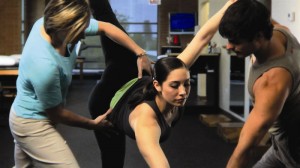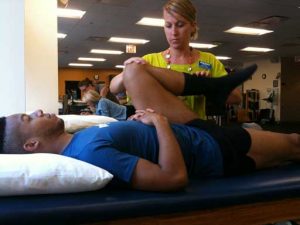
Your PLAN for an Injury-Free Summer Dance Intensive
Leave a CommentFor many dancers, summers are filled with morning to evening dance classes. Sometimes learning new styles, other times perfecting their technique in a familiar style. Often these summer dance intensives are away from home allowing the dancer to stay in a dormitory and meet new friends who have the same passion. Auditions for these programs are held months in advance and attention from renowned dance teachers may arise from this experience.
 While this may sound like a dream for a young dancer, summer dance intensives can become a recipe for injury. Morning to evening dance classes for multiple weeks can exhaust the body. New styles of dance may challenge the body in a way it is not trained to handle. Living away from home may decrease the nutritional value of meals and limit time spent resting the body. The prestige of getting into the program or the potential of high placement in the final performance may encourage a dancer to push through pain.
While this may sound like a dream for a young dancer, summer dance intensives can become a recipe for injury. Morning to evening dance classes for multiple weeks can exhaust the body. New styles of dance may challenge the body in a way it is not trained to handle. Living away from home may decrease the nutritional value of meals and limit time spent resting the body. The prestige of getting into the program or the potential of high placement in the final performance may encourage a dancer to push through pain.
In one study that examined injury rates during 3 consecutive years of a summer dance intensive, an average of 18% of dancers sought injury screenings at a walk-in physical therapy clinic during the 6-week program.1 While this may include first aid injuries and does not include dancers who sought treatment outside of the walk-in physical therapy clinic, it speaks to the high incidence of injuries that occur during summer dance intensives. The most common injuries experienced were related to the foot-ankle complex, pelvis-hip region, knee, and lumbar spine.1 Exacerbation of injuries experienced prior to the summer dance intensive were more likely to occur later in the program, while new injuries were more likely to occur early in the program.1 Of the dancers who did experience injury, it was more common that they experienced multiple injuries throughout the intensive rather than a single isolated injury.1 Risk for multiple injuries may be increased due to hypermobile joints, muscle weakness, muscle imbalance, and poor technique.1 Factors outside of the dancer’s control such as flooring, footwear, duration and frequency of classes, and choreography demands may also contribute to occurrence of multiple injuries.1
A PLAN for injury prevention is the key to a successful summer dance intensive.
PREPARE
LESSEN FATIGUE
ASK FOR HELP
NOURISH YOUR BODY
PREPARE
While packing for your summer dance intensive, it is important to be prepared for all circumstances. Make a list of all the supplies that you utilize during your typical week of dance classes then multiply the amount of supplies by the number of weeks you will be at the summer dance intensive. It is a good idea to bring a little extra of each supply, as it may be difficult to travel to a dance supply store at your summer dance intensive location. Other ideas include a basic first aid kit to manage unexpected cuts as well as a heating pad and cold packs to decrease muscle soreness or inflammation.
Remember to bring equipment such as foam rollers to manage tight muscles and resistance bands to maintain strength of key muscle groups. If you had physical therapy for an injury prior to the summer dance intensive, it will be important to continue the home exercises prescribed by your physical therapist prior to beginning the summer dance intensive.
In the weeks leading up to the summer dance intensive, be sure to add additional dance classes or increase cardiovascular conditioning to prepare your body for the increased frequency and intensity of dance classes as compared to your typical year-round program. Dancers with a lower level of physical fitness, as measured by a higher heart rate during aerobic activities, have an increased risk for injury as compared to dancers who are more physically fit due to reduced ability to recover between high-intensity bouts of exercise with resulting faulty alignment and inefficient biomechanics.2
While at the summer dance intensive, it is important to prepare your body for the demands of each class with a warm-up routine. Research shows that a cardiovascular warm-up followed by 30 seconds of various static stretches (hold in one pose) then 30 seconds of various dynamic stretches (repetitive movement into the desired stretch) results in optimal execution of important components of dance performance such as vertical jump, balance, and hamstring flexibility.3
LESSEN FATIGUE
Avoid excessive physical activities such as running, prolonged biking, and aerobics classes during the summer dance intensive in order to allow your body to recover. The effects of physical fatigue on dance injury rates have been well established.4 Fatigue has been found to decrease force generation in muscles, increase demand on passive tissues such as ligaments and joint capsules, and decrease feedback to the brain about joint position, which may inhibit ability to balance.4
Mental rest is important too! The National Sleep Foundation recommends 8 to 10 hours for 14-17 year olds and 7 to 9 hours for adults.5 This can be challenging to achieve in a dormitory environment but it is extremely important for injury prevention. Dance-related injuries have been associated with sleep disturbances, daytime sleepiness, stress, and negative mood states such as fatigue.6
ASK FOR HELP
 While some degree of muscle soreness is inevitable due to the demands of the program, pain that is altering your body’s movement should be acknowledged. By addressing a source of pain soon after it happens, there may be early treatment options or modifications to dance class that can be made to prevent a minor injury from turning into a major injury. Most summer dance intensives are associated with a specific group of physicians and physical therapists that specialize in treating dancers. Be sure to obtain this information before the start of the summer dance intensive in order to make this process occur smoothly if it is needed.
While some degree of muscle soreness is inevitable due to the demands of the program, pain that is altering your body’s movement should be acknowledged. By addressing a source of pain soon after it happens, there may be early treatment options or modifications to dance class that can be made to prevent a minor injury from turning into a major injury. Most summer dance intensives are associated with a specific group of physicians and physical therapists that specialize in treating dancers. Be sure to obtain this information before the start of the summer dance intensive in order to make this process occur smoothly if it is needed.
NOURISH YOUR BODY
Nutrition is the final component to a successful summer dance intensive. The International Association for Dance Medicine and Science (IADMS) recommends 45-50 calories per kilogram of body weight for females and 50-55 calories per kilogram of body weight for males during periods of heavy training such as summer dance intensives.7 IADMS states that a dancer’s diet should be 55-60% carbohydrates, 12-15% protein, and 20-30% fat but during periods of heavy training, carbohydrates should increase to 65% in order to provide energy to muscles and avoid fatigue during dance classes.7 For 14 to 50 year olds, the United States Department of Agriculture recommends 1.5-2 servings of fruit and 2.5 cups of vegetables per day.8 Address barriers such as money and access to healthy foods with your parents prior to leaving for the summer dance intensives. Utilize ChooseMyPlate.gov as a guideline for your healthy meal choices or contact a nutritionist to build a meal plan specifically for you.
Water consumption is crucial due to fluid loss that occurs during physical activity. Sweat is created to cool down the body as muscles produce heat when they contract to move your bones. During a hard or long dance class, you can lose up to 2 liters of water per hour.7 If that water is not restored, your concentration may be impaired which will limit your ability to quickly learn dance combinations. IADMS recommends 8oz every 15min (yes, you did the mental math correctly…that’s 32oz per hour!) so take advantage of breaks in class and bring a water bottle into class if permitted.7
Prepare. Lessen Fatigue. Ask for Help. Nourish Your Body. Now you have a PLAN to stay injury-free during your upcoming summer dance intensive programs!
Athletico provides complimentary injury screens at all of our clinics. Schedule your injury screen today! We also offer performing arts rehabilitation.
Click to Schedule a Complimentary Injury Screen
The Athletico blog is an educational resource written by Athletico employees. Athletico bloggers are licensed professionals who abide by the code of ethics outlined by their respective professional associations. The content published in blog posts represents the opinion of the individual author based on their expertise and experience. The content provided in this blog is for informational purposes only, does not constitute medical advice and should not be relied on for making personal health decisions.
- Fulton J, Burgi C, Canizares RC, Sheets C, Butler RJ. Injuries presenting to a walk-in clinic at a summer dance intensive program. J Dance Med Sci. 2014;18(3):131-135.
- Twitchett E, Brodrick A, Nevill AM, Koutedakis Y, Angioi M, Wyon M. Does physical fitness affect injury occurrence and time loss due to injury in elite vocational ballet students? J Dance Med Sci. 2010;14(1):26-31.
- Morrin N, Redding E. Acute effects of warm-up stretch protocols on balance, vertical jump height, and range of motion in dancers. J Dance Med Sci. 2013;17(1):34-40.
- Liederbach M, Schanfein L, Kremenic IJ. What is known about the effect of fatigue on injury occurrence among dancers? J Dance Med Sci. 2013;17(3):101-108.
- Sleep Duration Recommendations. National Sleep Foundation. https://sleepfoundation.org/sites/default/files/STREPchanges_1.png. Accessed June 19, 2016.
- Adam MU, Brassington GS, Steiner H, Matheson GO. Psychological factors associated with performance-limiting injuries in professional ballet dancers. J Dance Med Sci. 2004;8(2):43-46.
- Nutrition Fact Sheet: Fueling the Dancer. International Association of Dance Medicine and Science. https://c.ymcdn.com/sites/www.iadms.org/resource/resmgr/resource_papers/dance_nutrition.pdf. Accessed June 19, 2016.
